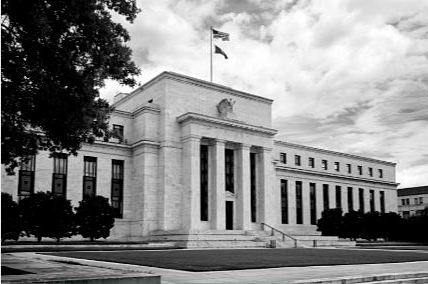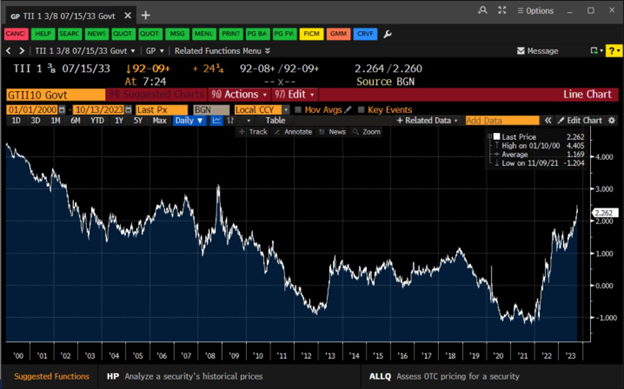Higher for Longer, Just Not Too High

Thoughts and prayers remain with the country and people of Israel. A combination of flight to quality and Fed speak has Treasury yields significantly off their highs since last week’s Friday’s employment report. The Fed is referencing clearly and specifically the recent rise in longer end real yields and the impact on financial conditions throughout the course of the summer. The challenge is: once they turn dovish rates coming ripping in and risk assets move higher. Nonetheless, they seem to have seen enough short term to want to quell the waters for now.
Let’s Take a Look:
A very complicated geopolitical landscape gets worse. It’s impossible to know exactly what form this takes over time, but we know a few risk factors are present in terms of expansion. At a minimal this will incorporate the unfortunate loss of life on the part of many civilians. And when lines like this are crossed, and we’ve experienced it firsthand in the United States, the painful journey begins.
Of all the variables we write and speak about geopolitical risk is at the top of unknowns. Clearly, rumblings of “something was about to happen” but akin to our September 11th a nation largely blindsided. This remains a story of watching what countries do, not so much what they say. In the end, we continue to remake history. And in many cases not constructive ways. The humanitarian side of what we’re experiencing is in many cases heart wrenching. And the implications for markets to date when looking at some serious chess pieces being moved around the globe, somewhat muted. Surprisingly so. For us, it’s difficult, almost impossible, to separate the geopolitical, de-globalization, resource focused, increased fiscal contribution, post-pandemic, inflation ridden world order from central bank policy and the economy.
This has been one heck of a year. Our expectations for the fourth quarter were nothing short of what we’ve already seen. The events have been impossible to predict but there’s been a clear sense of “waiting for the next shoe to drop”. They’ve been dropping in different forms and reasons. But the degrees of separation in terms of linkage very small in our opinion. Resources, policy, “what you have that I don’t and need”, divided politics (Israel included), misinformation (social media’s role 2023), higher rates, inflation, and who’s aligning with who. Alliances (potential) certainly played a role in the events over the weekend.
As always, attention turns to markets and economies. Hey, did you hear about the good employment number a week ago? With markets we will look for leadership in the form of the US dollar and oil. Of course, US Treasury rates. But the rate moves of late is being intertwined with dovish Fed speak. Up until the was in Israel, the correlation was higher rates, higher energy prices, stronger US dollar. This week, higher, higher, and US rates lower.
The US Dollar (White), Oil (Orange), and the US 10-year (White)

Market reactions in times of stress can be tricky. For central bankers this complicates an already difficult environment. And for the Fed, a good excuse to lean on their narrative of “caution”, coupled with a very explicit reference to the recent rise in longer-term real yields and perceived “term premium” in the US Treasury market. Sufficiently restrictive and at this point in the cycle more about the long end than short. And that’s been our focus throughout the summer and recent month. The US 10-year real yield.
10-Year Real Yields Normalizing but has the Fed’s Attention (see attachment)

There are many saying the market is now doing the Fed’s work. Perhaps. But the Fed has been sending a clear signal and the stars around the higher rate story have been aligning. Last week, a very thoughtful writeup from Dallas Fed President Lorie Logan in which she incorporates both the notion of a higher neural rate and a discussion around term premium (different models, varying results). For us, higher neutral we point to Washington and the fiscal spending and deficits. Term premium: The Fed’s balance sheet coupled with changing global dynamics (global is important here). And third we’ll throw in: Market structure, regulatory, and the “price of duration”.
Notably, financial conditions have been tightening over the summer (needed by the Fed but relevant). The move in real rates has NOT incorporated a meaningful shift with inflation expectations. But we are running war time deficits. Japan is loosening up (Middle East tension makes worse if energy prices continue to rise). Our biggest foreign buyers (UST) have tempered. Yes, the Fed is a subtle seller versus buyer. As Lorie Logan also points to the discussion on lowering the Fed Funds rate while continuing balance sheet runoff. Higher mortgage rates bringing a “selling begets selling market” (convexity). Yes, better economic growth at least for now with a curve that is shifting higher and steeper. Welcome to the 2023 global landscape.
In the end, meeting skips can turn into legitimate pauses. Markets are rational construing it this way. This is not to suggest the Fed will be lowering rates anytime soon, and if anything, bigger picture, the continued geopolitical events lend themselves to more stubborn inflation over time. A new world order. Continued de-globalizing factors, and subject to more supply side shocks. At a minimal, however, the speed and magnitude of the recent shift in long end rates has the Fed’s attention. There were no definitive conclusions in the speech of Dallas Fed President Logan. To our litany of puzzle pieces (Goolsbee), Lorie Logan asks which factor(s) is it? Lends to exactly what the Fed’s been preaching: Caution. It’s not clear exactly where rates top out but a new, higher range for long end rates will bite.
Short term we like the notion of the longer end of the US Treasury market finding a new range. Exploring lower rates from here given the magnitude of the most recent move higher makes sense. We’ve had three waves of higher 10-year rates over the course of the past few years. Each wave has incorporated moves of roughly 175-basis points. From this last March’s low of 3.30% to last week’s employment high of 4.90% we roughly achieved our objective. The Fed has turned explicitly dovish. Mutually exclusive from the war in Israel and very focused on the speed and magnitude that long end rates have moved higher. The message: higher for longer. Just not too high.




